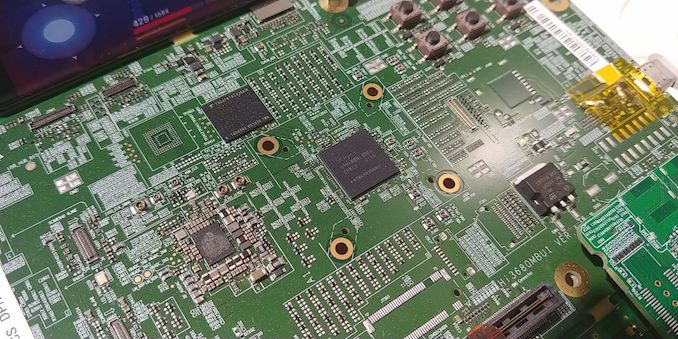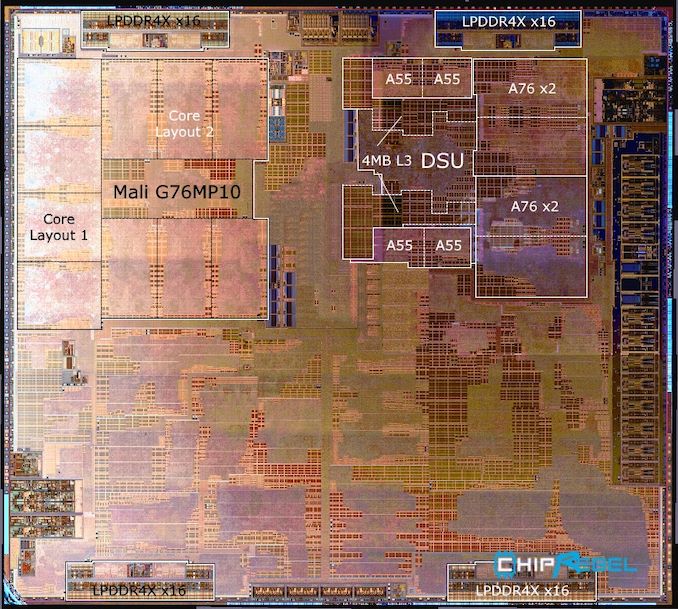ChipRebel Releases Kirin 980 Die Shot: Cortex A76's & Mali G76 in View
by Andrei Frumusanu on November 7, 2018 4:30 AM EST
When new flagship silicon chips are released, one thing that I always eagerly await is somebody publishing a die shot of said design. Over the past few years this has always been done by ChipWorks and subsequently TechInsights – but last year a little known site called ChipRebel caught my attention when they released a very high quality, high-resolution shot of the Apple A11. I’ve been in touch with the folks over there over the past few weeks, poking to see what their plans were, and was happy to hear that they’re trying to gain more traction in the future.
Yesterday ChipRebel released a preliminary teardown of the new Huawei Mate 20 – and along with it publicly released a low-res version of their Kirin 980 die shot, along with their commercial high-resolution shot. This is very exciting, as the new HiSilicon chip marks the second commercially available consumer 7nm chip – of course after Apple’s own A12 from just a few weeks prior. More importantly, this is the first time we’re seeing Arm’s new Cortex A76 CPUs as well as the new Mali G76 GPU.
I took the liberty to label some of the some more obvious block complexes of the SoC image on my own, and also shared this with the folks over at ChipRebel:

Die shot credit: ChipRebel - Block labelling: AnandTech
Second commercial 7nm SoC - Another tiny die!
First of all – the Kirin 980 is quite a lot smaller than HiSilicon had led to people to believe: Back when the chipset was announced, they had mentioned it was “under 100mm²”, with many thinking the die would be somewhere in the ballpark just below that figure. In reality, the Kirin 980 measures just a mere 74.13mm² - a 30% reduction compared to last year’s 96.72mm² Kirin 970 – even though the new chipset brings a lot of new features and more complexity.
On the top left corner we can see the new Mali G76MP10 GPU. The Mali G76 drastically differs from past generation Arm GPUs in that it essentially doubles the computational capabilities of each core – in effect that one could say that the new MP10 core configuration in the Kirin 980 is about equivalent to a MP20 of the previous generation – microarchitectural improvements aside.
On the right side we see the new CPU complex. This is HiSilicon’s first DynamIQ CPU configuration, as the company’s release schedule for the Kirin 970 last year made them miss out on the Cortex A75. For the Kirin 980 however, we see a configuration that fully takes advantage of the new DynamIQ flexibility: We have essentially one large CPU cluster, with different CPUs attached to it.
The centre complex is the DSU, the DynamIQ Shared Unit, essentially the L3 cache controller along with the tag RAMs as well as the large 4MB L3 cache itself. Flanked on both sides of the DSU we see the 4 Cortex A55 cores that clock up to 1.8GHz, each of these also sport private 128KB L2 caches.
Really nice to see on the die shot is the two pairs of Cortex A76 cores. HiSilicon employs the four cores into pairs, with each pair running on a dedicated voltage and frequency plane. We can see that the physical implementation between the two pairs very evidently differs, and this would confirm my suspicion that we’re looking at a frequency optimised pair, running at up to 2.6GHz, and a more power optimised pair, limited to 1.92GHz. Both pairs employ 512KB private L2 caches on each core.
An interesting thing is that it’s again extremely difficult to even locate the NPU on even the Kirin 980. HiSilicon describes this as a dual-core unit, however I can’t seem to find any matching block on the shot – if the company is using non-identical layouts for the two “cores”, then all bets are off in trying to identify this easily.
Overall, it’s great to have a new player in the die shot imaging scene, and hopefully the folks over at ChipRebel are able to gain more attention in order to be able to continue to share with us images of important future chip developments.
I’m finishing up my review of the Mate 20 and Mate 20 Pro – and we’ll go into more detail into the performance and power of the new Kirin 980 and the new Cortex A76 CPUs as well as the new Mali G76, so stay tuned!










27 Comments
View All Comments
Dragonstongue - Wednesday, November 7, 2018 - link
power optimised would be like 900Mhz and the 2.6 for the "performance" cores"They got the technology gentleman"
ZolaIII - Wednesday, November 7, 2018 - link
The bright side is that it looks like A76 is actually quite smaller than what I expected it will be but on the other hand it doesn't actually meet the performance increase promised by ARM (I calculated 50% gain clock per clock when compared to the A73/A72 while I expected about 66% still this way its ahead of my expectation for performance/gate). All in all it really looks like A76 is a remarkable design. Hopefully we will see more in depth analysis soon.Wilco1 - Wednesday, November 7, 2018 - link
Well according to Andrei's post here https://www.realworldtech.com/forum/?threadid=1812... it is about 80% IPC improvement on SPECINT and 100% on SPECFP over Cortex-A73. I don't see how that is less than promised, it looks far more. Combined with a small frequency increase we're looking at a solid doubling of performance in less than 2 years!ZolaIII - Thursday, November 8, 2018 - link
First off all it's in five years as A73 didn't bring any performance uplift compared to the A72, it whose however a more power efficient design. I base my projection on Geekbench publicly available scores not a server industrial one's. I specifically said clock per clock comparation. If you think how sustainable leakage threshold changed with smaller FinFET node's well think again. You either get a big reduction in power consumption or opportunity to get a modest clock bump at same consumption that's why wider OoO designs are bein made in the first place. As the looks of things A76 is less then 2x the size of the A73 while achieving 50% better performance is actually huge design win because it will use significantly less power at 2GHz then A73 on 3GHz disregarding of used node. To put the things into right perspective initial TSMC 7nm node has 2x density & 50% lower power consumption of the first generation 14 nm on which A73's ware build. On the other hand Samsung second gen 7nm HD node the first one with EUV had the 66/60% higher density than their 10 nm LPE/14 nm UHD third generation (11nm). As the things go you want be going frequency bumps neither now nor in the future. We will see & discus about A76 after the Andrei is finished, before that it simply doesn't have sense.NICOXIS - Thursday, November 8, 2018 - link
Why would anyone take geekbench over a standarized server benchmark to compare CPU designs? Anandtech already proved its inconsistencies during the Exynos 9810 vs SD845 S9 review.ZolaIII - Friday, November 9, 2018 - link
Because this ain't server CPU nor will be used like that. While being far from optimal Geekbench is a set of comprehensive benchmarks. You cant get consistent result on something like Android at all. What you can get are normalised ones on large pattern.Wilco1 - Thursday, November 8, 2018 - link
5 years?!? Even Cortex-A57 is less than 4 years old, first Exynos using it was late 2014... Cortex-A72 was never popular in high-end phones, both QC and Samsung went straight to Cortex-A73 after Cortex-A57.Even if GB4 shows 50% IPC gain overall, it looks IPC on floating point is also up 2x like SPECFP. It's not clear why, maybe FP and SPEC benefit more from the better memory system and larger caches.
ZolaIII - Friday, November 9, 2018 - link
Neither of them went straight to A73...when I say 5 years I mean it!Take a look at references at wiki.
https://en.m.wikipedia.org/wiki/ARM_Cortex-A72
SIMD (NEON) does indeed benefit a lot from faster access & it whose almost at the point of being useless on A72, A73's because it whose only a little bit faster than VFP. So 2x on SIMD still ain't all that much. It's still less than two A55's which use half the power. Until SSE kicks in & on small core's you won't see anything remarkable regarding FPU SIMD performance on ARM. Even it precompiled version of Geekbench is pretty bad regarding optimisations for any platform it's still good enough pointer what you will be getting in the real world.
Wilco1 - Saturday, November 10, 2018 - link
You seem to have an issue with counting, 5 years ago Cortex-A72 didn't exist and phones were all 32 bit. First Cortex-A72 in a high-end mobile was early 2016, less than 3 years ago: https://www.anandtech.com/show/9878/the-huawei-mat...ZolaIII - Sunday, November 11, 2018 - link
Technically it's 4 years & 9 months since Cortex A72 whose publicly announced by ARM. Your intelligence whose non existed then as it is now not even on tau level (two bit).